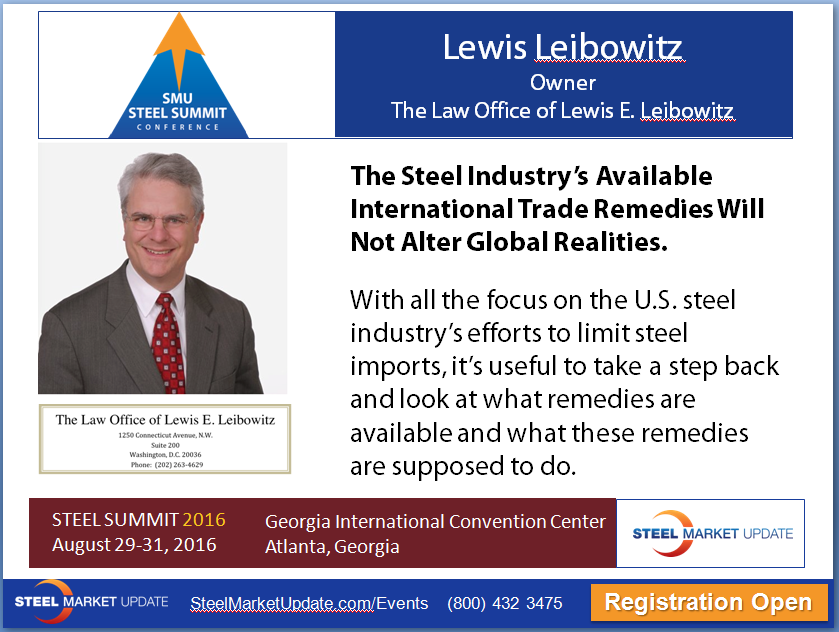Trade Cases

The Steel Industry’s Available International Trade Remedies Will Not Alter Global Realities
Written by Lewis Leibowitz
April 18, 2016
Last week hearings were held in Washington, D.C. regarding the plight of the domestic steel industry, world over-capacity of steel production (with a special emphasis on China). During the hearings a number of trade remedies were mentioned such as Section 201 and Section 232 along with the antidumping and countervailing duty flat rolled steel trade cases already in process. We asked trade attorney Lewis Leibowitz to comment on what remedies are realistically available and what they mean for the steel industry. Mr. Leibowitz will be conducting a special “Pre-Summit” program on Monday, August 29th as part of our Steel Summit 2016.
By Lewis Leibowitz, The Law Offices of Lewis E Leibowitz
With all the focus on the US steel industry’s efforts to limit steel imports, it’s useful to take a step back and look at what remedies are available and what these remedies are supposed to do. The steel industry has employed these cases many times over the last half century in an effort to reduce imports. In its current distress, steel producers have employed trade litigation already. Rumors abound that the industry will use these and several other remedies. Perhaps they will try to enact a few new ones.
Let’s start with antidumping cases. “Dumping” means that a foreign steel producer sells a product for less than its “normal value” (the higher of home market prices or a value based on the cost of production of the product in their home market). In a few cases normal value could be the prices sold to a third-country export market.
The Commerce Department determines if “dumping” is taking place; the International Trade Commission, a six-member independent agency, determines if the dumping is causing or threatening “material injury” to the domestic industry that filed the case. The impact of the remedy on the economy is generally not considered directly, but it may be an indirect consideration. When antidumping margins are set, importers must pay the estimated duty as a condition of entry of the products into the US market.
Countervailing duty cases determine whether foreign government subsidies benefit the production or sale of a product. Commerce measures these subsidies and, like the antidumping statute, the ITC determines injury. When subsidy margins are set, importers must pay the estimated duty as a condition of entry of their products. When antidumping and countervailing duties affect the same products, the estimated duties are cumulative—thus, importers must pay the combined estimated duties. When export subsidies (benefits conditional upon exports) are involved, the amount of countervailing duties based on export subsidies is deducted from the antidumping duty deposits. This adjustment is based on the rules of international trade agreements negotiated in the WTO.
Section 201 (the “safeguard” law) has also been used by the steel industry over the years, most recently in 2001. Unlike antidumping and countervailing duty cases, safeguards do not determine whether “unfair trade” (dumping or subsidies) affects trade. The only issue is whether increasing imports cause or threaten “serious injury” (a higher standard than “material injury”). The President of the United States may impose import restrictions (tariffs or quotas) on the products; but under the statute and international trade rules, the restrictions may only be temporary (five years at the most, which may be extended for an additional three years). In safeguard cases, the President measures the impact of relief on the economy, and can make adjustments to the restrictions to take account of those impacts. President George W. Bush did this in 2002-03, the last time safeguard measures were imposed.
The steel case resulted in a massive WTO case brought by Europe, Japan and other countries against the measures imposed by the US. The US lost that case, and lifted the safeguard measures before threatened retaliation could be imposed. The WTO case has made further safeguard measures by the United States a dangerous prospect because of the threat of retaliation. The US safeguards statute seems to be flatly inconsistent with the WTO rules, so our trading partners will likely challenge any new US safeguard case. Moreover, the purpose of safeguards is to provide a temporary opportunity for the domestic industry to adjust to the realities of international competition. It is not intended to alter those realities or to provide permanent insulation from them.
Section 232 of the Trade Expansion Act of 1962 allows the President to impose import restrictions against imports that threated to harm the national security of the United States. This law has been invoked 27 times since the law was passed in 1962.
Under the current procedure the Commerce Department’s Bureau of Industry and Security conducts an investigation when a request is filed on behalf of an industry or the President. After a report is prepared, the President makes the final determination whether imports threaten the national security interests of the United States. If so, the President then has the discretion to take action against those imports. It is possible that the President would take no action even if a national security threat were found.
Of the 27 cases initiated, nine involved steel (three cases on antifriction bearings, three on ferroalloys, one on iron ore and semifinished steel and two on nuts, bolts and screws), but none was based on imports of finished steel products, such as plates, sheets, wire rod or rails. Perhaps the most relevant of these cases is the most recent, the case concerning iron or and semifinished steel products. In that case, the Department of Commerce was unable to conclude, despite the distressed condition of the US industry, that the national security interests of the United States were impaired. None of the nine cases determined that the national security was impaired by the imports being investigated, but in one case (one of the ferroalloy cases, decided in 1984, certain import restrictions were ordered by President Ronald Reagan on imports of certain ferroalloys).
Finally, Section 337 of the Tariff Act of 1930 provides for relief from imports that violate US intellectual property rights. Where complaining parties show patent trademark or copyright infringement, violation of trade secrets or other IP related offenses, the ITC can order exclusion of the offending products from importation or order the respondents to “cease and desist” their violations. Unlike court litigation, the ITC cannot award money damages. Cases are often settled based on licensing agreements.
Perhaps it’s worth mentioning that the steel industry has often employed trade litigation (or the threat of trade litigation) as a tactic when it is in economic trouble. These actions resulted on many occasions in international agreements to restrain trade in steel products to defuse tensions and avoid international disputes. Steel VRAs were negotiated in the 1960s when antidumping and countervailing duty cases were threatened. In the 1970s, the “trigger price mechanism” avoided another round of antidumping cases. When that did not reduce imports to the degree the steel industry wanted, they made good on their threats to file cases in 1980 and 1982, putting an end to the trigger price mechanism and introducing countervailing duty cases into the arsenal. These cases were largely settled by negotiation of a second round of steel VRAs, first with the European Community in 1982 and then with most other steel-producing countries in 1984 (not including China, which was a very minor player then), resolving a steel safeguard action.
The steel VRAs expired in 1992. The steel industry’s efforts to extend them failed because of opposition by steel consuming industries. Steel producers again filed antidumping and countervailing duty cases. In 1993 the WTO agreements were negotiated, including the safeguards agreement that essentially outlawed further steel VRAs as “gray area measures” not countenanced by WTO members.
The steel industry’s efforts to solve the growth of steel production beyond the reach of demand for steel has now entered a new phase. Steel has filed a large number of antidumping and countervailing duty cases, which will result in high duties for a number of producers. Foreign producers that consider the US market critical to their future will be able to adjust their prices and government aid programs to reduce antidumping and countervailing duties over time. The other trade remedy statutes are similarly designed to foster adjustment through temporary restrictions. National security does not seem a promising avenue for steel, because the strategic needs of the United States do not depend heavily on steel.
Is there anything that the industry and its supporters can do? I am sure we will find out. The significant growth of steel production in China and to a lesser extent in other developing countries like India will send countries scrambling to keep foreign producers seeking new markets from entering their countries. Antidumping and countervailing duty cases remain the only measures that can give long-term relief from imports. But over a longer period of time, products containing steel that are not covered by the antidumping and countervailing duty cases (indirect imports) will dampen the impact of the relief as customers adjust their purchasing patterns. The available remedies will not stop the world from continuing its evolution.

Lewis Leibowitz
Read more from Lewis LeibowitzLatest in Trade Cases

USTR targets China in new 301 probe; Biden calls for higher tariffs
The Biden administration on Wednesday announced measures to support the domestic steel industry.

Price: New trade rules will help domestic industries fight “unfair” trade
The Department of Commerce (DOC) has issued new rules to combat evolving "unfair" trade practice — including the unfair trade of steel products. They go into effect on Wednesday, April 24.

CRU: Mexico to toughen controls on steel imports
To ease trade tensions with the United States, the economy ministry in Mexico is preparing measures to strengthen definitions on steel being shipped into the country. Mexico has faced accusations it is being used as a route for steel and aluminum produced in Asia to be sent on to the US, so-called triangulation.

Biden reiterates position on USS sale
President Biden said on Wednesday he would stand by his commitment to US workers regarding the proposed sale of U.S. Steel to Japan’s Nippon Steel.

Japan’s Kishida and Biden to meet amid tensions around USS sale
Japanese Prime Minister Fumio Kishida will be in Washington this week where one topic under discussion with President Biden will be U.S. Steel's proposed sale to Nippon Steel.

